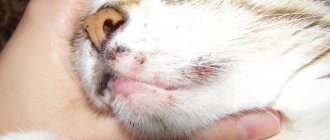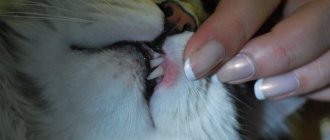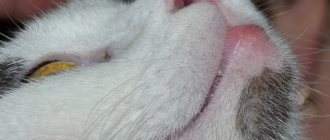Keratitis in cats is another of the most common ophthalmological diseases of pets. What kind of disease is this? Why does it happen? What types of keratitis in cats exist, as well as the main symptoms and methods of treating keratitis in cats at home, will be discussed in our article.
Keratitis is an inflammation of the cornea. Recognizing this disease is not so difficult, because normally the cornea is transparent and shiny. But as soon as the inflammatory process “captures” it, the eye immediately becomes cloudy. In most cases (almost 100%), keratitis in cats is acquired.
Causes
Next, we will look at the main causes of keratitis in cats in order from most likely to least likely:
- Often, keratitis in cats develops due to mechanical impact on the cornea (solid particles, grains of sand, dust particles, twigs and much more).
- Not less often, inflammation of the cornea develops together with conjunctivitis (inflammation of the conjunctiva - the mucous membrane of the eyelids). When a cat blinks, the mucous membrane of the eyelid is tightly adjacent to the cornea, and bacteria (and they will certainly appear on the sensitive inflamed tissue) enter the cornea, leading to an inflammatory process.
- Don’t forget about eye burns (thermal, chemical), which are difficult to treat.
- Infectious diseases. In this case, keratitis or keratoconjunctivitis will already be a symptom of an infectious disease (adenovirosis, herpes, calcivirosis and others). And the pet needs to be treated comprehensively, because local therapy will only remove the symptoms of eye diseases, but the underlying disease will “rage.”
- Allergy. She can develop into anything. And without qualified help it will be difficult to help your pet.
- Autoimmune.
- Blockage or inflammation of the tear glands. Because of this, the cornea and conjunctiva dry out.
- Vitamin deficiencies.
- Genetic predisposition.
Most often, Britons, Siamese, Persians, Sphynxes and American Smoothhairs are predisposed to keratitis.
Types of keratitis and diagnosis
A fairly wide range of studies can be used in diagnosing the causes of blepharitis, depending on the cause of their development:
- donate eye washes or blood for eye infections;
- exclude a traumatic factor, such as entropion of the eyelids, their abnormal development or underdevelopment;
- exclude penetrating wounds through the cornea and any injuries caused by mechanical damage to the cornea and leading to keratitis;
- check the amount of tears produced and compare it with the norms for cats;
- exclude problems inside the eye, such as uveitis, tumors, glaucoma, cataracts and others;
- take cytology tests to exclude neoplasms or autoimmune processes (this is done quite rarely).
It is possible to identify the disease only through an external examination of the animal. But to get ahead of the location of the infection, biomicroscopy is used. If purulent keratitis is detected, then bacteriological tests are taken to find out the source of the disease. Fluorescent strips are used to determine the stage of the lesion and light sensitivity.
There are several types of the disease:
- Ulcerative keratitis. It will most likely be caused by eye injury. An ulcer forms on the corneal tissue, which in its advanced form turns into purulent keratitis. It proceeds slowly. Since the cornea is insensitive in this form, it does not cause discomfort to the cat.
- Chronic degenerative keratitis is more common in certain breeds such as Siamese, Persian, Himalayan and Burmese (breeds with short faces and large eyes), so it is thought to be caused by genetic factors, or may be caused by frequent eye infections;
- Eosinophilic keratitis is a condition that begins as keratitis but progresses until the cornea turns pinkish and the affected eye becomes covered with a white film, most often caused by a herpes virus infection.
We suggest you read: A cat does not have milk after giving birth, reasons for what to do to restore lactation and what to feed kittens
A cat that is suspected of having an eye disease should be examined by a veterinarian. Symptoms can be clearly visible to the eye infection and the host.
The veterinarian will examine the corneal tissue under a microscope to see if it is damaged or if there are any viruses causing irritation. A culture test will be performed. The condition of both eyes is analyzed for the degree of damage to the corneal tissue. The veterinarian will also determine how the treatment is progressing, whether the condition is improving or whether therapy still needs to be continued.
Symptoms
Symptoms of keratitis in cats will allow the owner to recognize the disease in time and contact a veterinarian for help. Below we have prepared the most striking of them, as well as photos of the disease, so that you can understand more clearly whether you have encountered it.
- The cornea becomes cloudy and becomes as if rough (matte). And such a lesion can occur either in one eye or in both eyes at once.
- Sometimes the cornea grows blood vessels.
- Infiltration (fluid inside the cornea) accumulates, causing the upper layer of the eye to swell.
- It's leaking from the inflamed eye. The fur underneath is wet. Pus may accumulate in the corners.
- If the disease has gone too far, scars may occur. Alas, further therapy will not give visible results, the cat is going blind.
- Terrible photophobia. Agree, a healthy cat happily lies in the sun, but if the animal’s cornea is inflamed, then the mustache will hide from the bright rays of the sun or lamp.
Varieties
| Classification | Description |
| Spicy | Develops due to burns and injuries |
| Chronic | Progresses against the background of infections of the visual organ |
| Often affects breeds with short muzzles and large eyes | |
| Refers to genetic disorders | |
| Ulcerative | Slow onset with corneal lesions in cats |
| Caused by injury | |
| First, an abscess appears, which turns into an ulcer | |
| Eosinophilic | Appears due to herpes |
Eye disease in an animal can be viral in nature.
In addition, there are similar types of keratitis:
- allergic;
- fungal;
- viral;
- vascular;
- infectious.
Treatment
Treatment of cats for keratitis at home always begins with eliminating the cause! Without this, it is simply impossible to restore normal vision to your pet. It is not so easy to get rid of corneal inflammation.
Yes, hormonal or antimicrobial drugs can give a positive result, but if the cause remains unresolved, then sooner or later the keratitis will return. Antibiotic eye drops are most commonly used. If fungi are to blame, then fungicidal agents are required. Unfortunately, antifungal drugs are prescribed for a very long course of treatment. And it is not always possible to achieve positive results.
If the cause is a virus, then it is necessary to use specific serums. Without them, recovery will be almost impossible. But once the mustache is cured of the underlying (viral or even bacterial) disease, keratitis in cats goes away on its own.
How to treat?
The question of how to treat keratitis in cats can be answered after identifying factors such as:
- cause of illness;
- severity of the disease;
- depth of corneal lesion.
Eye keratitis in cats is treated with ointments and eye drops. Sometimes animals are given injections under the conjunctiva. The veterinarian may also prescribe tablets, subcutaneous or intravenous injections.
To treat viral keratitis, antiviral therapy is used - interferon-containing drugs. Complications caused by bacteria are treated with antibiotics and sulfa drugs.
For allergic keratitis, local and general antiallergic drugs are prescribed. If there is a threat of corneal perforation, corneal plastic surgery is performed to varying extents.
Possible complications
When the first symptoms of the disease appear, pet owners need to take urgent measures and immediately seek medical help. The lack of medical diagnosis and adequate treatment often leads to the transition of acute keratitis to a chronic form.
Chronicity of the disease is considered extremely undesirable. This type of pathology is very difficult to treat and often leads to deterioration of vision.
Other possible complications include:
- cataract;
- glaucoma;
- ulceration of eye tissue;
- corneal breakthrough;
- formation of a cataract.
The herpes virus, which causes eye damage in cats, tends to quickly spread to neighboring organs and systems. Often the pathogen causes various pathologies in the respiratory tract and respiratory tract.
The most dangerous type of disease for cat eyes is the bacterial type. In the later stages, this form of keratitis occurs with the formation of abscesses in the organs of vision. At the next stage, scar formation and complete and irreversible loss of visual function occur.
Ulcerative keratitis
Neurogenic or otherwise, ulcerative keratitis in cats occurs due to damage to the trophic nervous tissue of the animal. The result of the disease is the formation of a flat ulcer on the cornea. This is a long and sluggish process, but the cat does not experience pain or discomfort, because there is no sensitivity of the cornea. If the outcome of the disease is favorable, the ulcer goes away, and a slight cloudiness remains on the eye.
But if a secondary infection occurs, purulent keratitis develops in cats, which can lead to complete destruction of the cornea.
The appearance of ulcerative keratitis is associated with pathologies of the animal’s body:
- hypovitaminosis;
- diabetes;
- metabolic disease;
- chronic renal failure.
The development of the disease is influenced by the general state of the immune system. It also affects the severity of the pathological process and the nature of the course of keratitis.
Treatment of ulcerative keratitis in cats consists of eliminating the causes of inflammation and using antiseptic solutions:
- rivanol – 1%;
- furatsilin – 1:5000;
- boric acid – 3%.
Forms of violation
Feline keratitis can take two forms:
- Spicy.
- Chronic.
The acute form of the disease develops rapidly. With this type of pathology, the patient's condition worsens within a few hours. It is typical for acute keratitis to manifest itself against the background of existing ophthalmological problems, intoxication, injuries to the visual organ, and the presence of foreign objects in the eyeballs. In case of untimely treatment, acute keratitis often becomes chronic.
Chronic keratitis, also called vascular or pigmentary, is characterized by a long development - from several weeks to 2-3 months or a whole year. This form of disorder is provoked by long-term purulent conjunctivitis, dry eye syndrome, chronic bacterial or viral infections. Sometimes the cause of the disease in cats is helminthic infestations.
Keratitis in animals can also be local and total. In the first case, individual areas of the cornea are affected, and small cloudy spots are found in the eye. If there is a total form of the disease, the entire surface of the cornea is covered by the inflammatory process. The consequences of this are a severe decrease in visual acuity and even blindness.
Eosinophilic keratitis
A disease such as feline eosinophilic keratitis is an infiltration of the cornea by blood cells - eosinophils.
The reasons that cause the development of eosinophilic keratitis may be different, but, as doctors have noted, the herpes virus is often to blame. Another provoking factor may be stimulation of the immune system. This disease is chronic and relapses occur frequently.
In terms of treatment, anti-inflammatory and immunomodulatory drugs such as cyclosporine and corticosteroids are used. Sometimes antiviral drugs are prescribed. If in your case the cat’s keratitis is recurrent, it makes sense to keep the animal on long-term, maintenance therapy.
There is also such a thing as feline bullous keratitis. This disease is characterized by the formation of fluid-filled blisters on the cornea. This type of disease is treated with standard medications used to rid a cat of keratitis. As an example, the drug “Solcoseryl”.
Keratitis in a kitten
If a cat has keratitis, that’s one thing. People study treatment methods and boldly begin to treat the disease at home or take their pet to the veterinarian. It’s another matter when the disease affects the baby and here the questions begin - how to treat keratitis in a kitten, what medications will not harm the baby’s eye.
I hasten to reassure you - the treatment of keratitis in cats and kittens is no different. Therefore, give your baby medications suitable for a specific type of eye keratitis without hesitation. The only thing worth considering is the dosage of the medicine. If you doubt the amount of the drug sufficient to treat a kitten, take your pet to a veterinary clinic.
Therapy methods
Treatment at home is carried out as prescribed by a veterinarian.
For infectious pathologies, antibiotics are used, and antibacterial agents can be used.
Identified corneal ulcers and glaucoma require surgical intervention. Often, for glaucoma, complete removal of the eye is performed.
Excision of corneal ulcers is a less painful procedure. During this procedure, only the affected tissue is removed. After the procedure, scars remain that prevent full restoration of vision.
Therapy is carried out using non-steroidal anti-inflammatory drugs. The drugs have an impressive list of contraindications and, with prolonged treatment, can negatively affect the general condition of the animal .
For any pathologies, it is recommended for the cat to drip antiseptic drugs and apply medicinal ointments. At the same time, the affected organ is moisturized.
With timely treatment, it is possible to prevent the penetration of pathogenic microorganisms.
The cat needs to create comfortable conditions. He needs rest and diet.
Sometimes complex therapy is used:
- use of Gamavit and Tetracycline ointment;
- washing the organ with Metrogyl solution;
- use of drugs containing Actovegin;
- prescription of antiviral drugs.
Traditional methods of treatment
Traditional medicine should be used carefully. It is advisable to consult a veterinarian before starting therapy.
The following remedies will help alleviate your pet's condition:
- Tea. 1 tbsp is poured into a glass. dry tea leaves, pour boiling water. Use after completely cooled.
- Elder. To prepare the medicine, 1 tsp. elderberries are poured with boiling water (0.5 cups). Let the liquid infuse for about an hour and filter.
- Celandine. Five leaves pour 2 tbsp. boiling water The liquid is infused for half an hour, then filtered.
- Calendula: 2 tbsp. raw materials are poured with a glass of boiling water, left for a quarter of an hour, filtered.
- Aloe. Three leaves are crushed in a blender, the juice is filtered using gauze.
Medicines are used as follows:
- moisten a cotton pad in the liquid and move it from the outer corner to the inner one;
- change the cotton pad after each wipe;
- both eyelids are treated.
Prevention
Prevention is always better than cure. Keratitis in cats is no exception.
- Don't forget about vaccination. Timely vaccinations help create strong immunity, which will protect the animal from infection. This means that the risk that the cat will develop keratitis is much less.
- Examine your cat's eyes after being outside. If you notice watery eyes, again carefully examine your eyes to rule out exposure to mechanical irritants.
- The house must be clean. Wipe off dust thoroughly and wash floors.
- Brush your pet. Lost hair can also get into the eye and rub the conjunctiva and cornea, causing inflammation.
- Watch your diet, don’t forget about fortification and deworming. Strengthen the immunity of your beloved four-legged friend.
- As always, no self-medication. An erroneous self-diagnosis and treatment chosen “on your own” or based on advice from the Internet can only harm the pet. The cat will lose his sight once and for all.
If you have any questions on the topic of keratitis in cats, write them in the comments! We will definitely answer!











